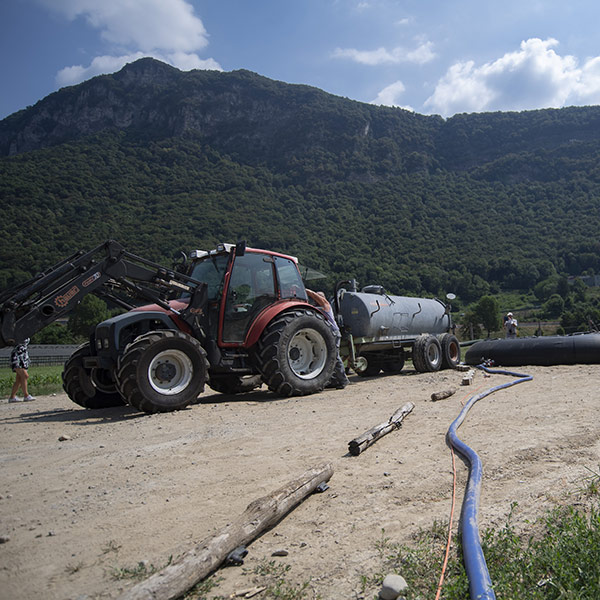OCEANOGRAPHY
What flows beneath the Gulf Stream
There have been repeated warnings that global warming will bring the Atlantic current system to a standstill. We go on an explorative tour of the deep ocean of data, which ranges from the alarmist to the merely pessimistic.

When Greenland’s ice melts, the currents in the Atlantic slow down, which in turn has an impact on the climate. | Photo: Arctic Images / Getty Images
Superstorms rage over the northern hemisphere, temperatures plummet in just a few hours, and New Delhi experiences several metres of snow. The reason for all this is that the Gulf Stream, which has brought warmth to the North Atlantic for thousands of years, has ceased to flow. This nightmare imagery of a stagnant Gulf Stream is the scenario of a Hollywood blockbuster that was in the movie theatres 20 years ago: ‘The Day After Tomorrow’. “The notion that the Gulf Stream could cease to flow within a few days, like in the movie, is alarmist”, says Thomas Frölicher, a climate researcher at the University of Bern. “Processes like that happen over periods of 50 to 100 years”.
Frölicher is studying the increasingly frequent phenomenon of marine heatwaves. As for the Gulf Stream, he can give it the all-clear for now. “The Gulf Stream will never cease to flow, because it’s wind-driven”. All the same, experts like Frölicher are warning that climate-relevant changes of global proportions are undoubtedly taking place in the North Atlantic. They are focussing on the so-called Atlantic meridional overturning circulation, ‘AMOC’ for short, which people often equate with the Gulf Stream itself.
15 million cubic metres per second
The Gulf Stream – a warm, surface current running between Florida and Europe – is in fact only a small part of the AMOC, which is a system of currents stretching across the entire Atlantic, from the Antarctic Ocean to the far north. It transports gigantic quantities of water around the world – 15 million cubic metres per second – and ultimately is responsible for bringing the most warmth to the North Atlantic. For now. Some climate researchers claim that its engine might well be stuttering.
This ‘engine’ is located in the North Atlantic, where the surface water cools down, thereby increasing in density, and sinks down before flowing southwards along the sea floor at depths of up to 3,000 metres. If this sinking process is interrupted – say, by freshwater from melting ice that is less dense, perhaps from the Greenland Ice Sheet – this can weaken the circulation. Some scientists, including a team from the University of Copenhagen that has recently been investigating the AMOC, believe that it could quite possibly come to a complete standstill as early as 2025. “If the AMOC were to cease flowing, or just slow down considerably, this would have a significant impact on our climate”, says Frölicher.
The consequences of such a shutdown would be felt across the world, resulting in the sea level rising along the eastern seaboard of North America, storms up to hurricane force in Europe, plummeting temperatures in the northern hemisphere, and rising temperatures in the South. The North Atlantic would cool down, which would also have an impact on large-scale weather systems such as the Indian monsoons.
Researchers have known for decades that the AMOC has a tipping point at which it can become unstable. “We just don’t know exactly where it lies”, says Frölicher. “But if the Earth warms up by between 1.5 and 2.5 degrees Celsius, the risk increases significantly that we’ll exceed that tipping point”.
Too little data from the deep
This is why researchers are trying to obtain more precise data about the mighty AMOC. “We still have a surprisingly poor understanding of it”, says Niklas Boers, a climate researcher at the Technical University of Munich who also works at the Potsdam Institute for Climate Impact Research. “We have a massive problem with the measurement data”. It’s only since 2004 that two large oceanographic programmes have been observing the AMOC’s system of currents – knowing full well that the time available might not be sufficient to understand its dynamics in full.
Short-term slowdowns in the current of up to 20 percent, such as have been measured since 2004, might be normal and effect no major changes in the overall dynamics. “We are dealing with strong, non-linear phenomena”, says Boers. If they want truly valid calculations, climate researchers would need data over a period of at least 100 years. What’s more, they measure the speed and salinity of the AMOC mostly at the surface, not at depth, and only in certain places.
This lack of long-term data means that researchers tend to rely on short-term indicators for their models. The salinity of the South Atlantic is one of them, along with changes in a specific region in the North Atlantic that’s known as the subpolar ‘cold blob’. The controversial study of July 2023 by the statistician Susanne Ditlevsen and the climate physicist Peter Ditlevsen from the University of Copenhagen, mentioned above, used this cold blob as the basis for their model. Their analysis caused a stir when they claimed that there is a 95 percent probability that the AMOC will collapse by the year 2095, and possibly as early as 2025.
Climate researchers around the world have expressed serious doubts about the validity of this model, especially about its claim that small shifts in temperature in the cold blob could cause the circulation to alter relatively quickly. Niklas Boers believes that this is a “gross simplification”. Statistical uncertainties mean that the tipping point of the AMOC could occur at some point “between today and the year 5000”, he says, and even this prognosis is based on highly simplified assumptions that might not necessarily apply in the real world.
Boers’s own models also utilise short-term indicators. But his prime concern is trying to test the stability of the AMOC’s current system. For example, he wants to find out just how sensitively its current reacts to short-term disturbances such as weather fluctuations that we can actually observe. “From a physical point of view, we can see that the stabilising forces become weaker when the system is put briefly out of balance”, he says. “This could be a serious indication that we are indeed approaching the AMOC’s tipping point”.
The last Ice Age didn’t lead to collapse
Modelling is just one way of trying to understand the AMOC. We can also get other, valuable clues by looking into the past. Palaeoclimatologists drill into the Earth and use their drill cores to try and find evidence of abrupt changes to the world’s water cycle. Over the course of the Earth’s history, the AMOC has also come to a standstill without any intervention from humans – such as 55 million years ago during the so-called Paleocene-Eocene thermal maximum, when temperatures rose abruptly. Instabilities in the AMOC also led to shifts in the climate during the last Ice Age. These included the so-called Dansgaard-Oeschger events that occurred between 15,000 and 120,000 years ago that are co-named after Hans Oeschger (1927–98), a physicist and climate pioneer from Bern.
In April 2023, Frerk Pöppelmeier and Thomas Stocker – both climate physicists at the University of Bern’s Oeschger Centre (named in honour of their predecessor) – published a study in Nature Geoscience on the processes that took place at the end of the most recent Ice Age, 15,000 years ago, when the ice sheets over northern Europe and North America began to melt. “That created a kind of freshwater lid in the North Atlantic”, says Pöppelmeier. Besides its lower density, this lid prevented the surface water from cooling sufficiently, which led to a weakening of the AMOC. But its circulation during the last Ice Age was in any case in a significantly different state from what it is today.
Pöppelmeier and Stocker have been analysing ice cores and sediment cores from the entire Atlantic region. Ocean current indicators suggest that less meltwater flowed into the North Atlantic at the beginning of the last Ice Age than was previously assumed. “Despite the rise in temperature back then, the AMOC didn’t collapse completely, but was only weakened”, says Pöppelmeier.
The circulation has lost stability
The models of past changes in the AMOC can help climate researchers to achieve a better understanding of today’s dynamics, allowing them to document the manmade impact of increased CO2 emissions while at the same time minimising the uncertainties of current models. It seems likely that the AMOC will continue to slow down over the 21st century. But it remains unclear whether it might indeed come to a standstill. According to Stocker, climate scientists still know too little about the tipping points to be able to make robust statements about how close we might already be to threshold values.
Boers is currently working on a study that takes such uncertainties into account. For him, however, one thing is quite clear: “The AMOC has lost stability in the last century, and the increase in man-made global warming means we are heading towards a possible tipping point. We’re playing with fire if we don’t reduce CO2 emissions to zero as quickly as we can”.




